Search Thermo Fisher Scientific
Invitrogen
P-Glycoprotein Recombinant Rabbit Monoclonal Antibody (SN06-42)
This Antibody was verified by Knockout to ensure that the antibody binds to the antigen stated.
FIGURE: 1 / 10
P-Glycoprotein Antibody (MA5-32282) in ICC/IF
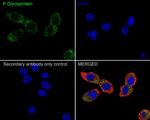
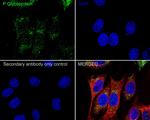
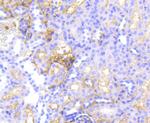
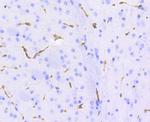
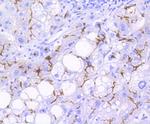
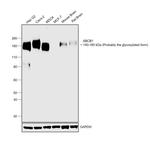


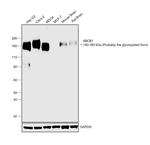

Product Details
MA5-32282
Species Reactivity
Published species
Host/Isotype
Expression System
Class
Type
Clone
Immunogen
Conjugate
Form
Concentration
Purification
Storage buffer
Contains
Storage conditions
Shipping conditions
RRID
Product Specific Information
Recombinant rabbit monoclonal antibodies are produced using in vitro expression systems. The expression systems are developed by cloning in the specific antibody DNA sequences from immunoreactive rabbits. Then, individual clones are screened to select the best candidates for production. The advantages of using recombinant rabbit monoclonal antibodies include: better specificity and sensitivity, lot-to-lot consistency, animal origin-free formulations, and broader immunoreactivity to diverse targets due to larger rabbit immune repertoire.
Target Information
The membrane-associated protein encoded by this gene is a member of the superfamily of ATP-binding cassette (ABC) transporters. ABC proteins transport various molecules across extra- and intra-cellular membranes. ABC genes are divided into seven distinct subfamilies (ABC1, MDR/TAP, MRP, ALD, OABP, GCN20, White). This protein is a member of the MDR/TAP subfamily. Members of the MDR/TAP subfamily are involved in multidrug resistance. The protein encoded by this gene is an ATP-dependent drug efflux pump for xenobiotic compounds with broad substrate specificity. It is responsible for decreased drug accumulation in multidrug-resistant cells and often mediates the development of resistance to anticancer drugs. This protein also functions as a transporter in the blood-brain barrier.
For Research Use Only. Not for use in diagnostic procedures. Not for resale without express authorization.
Bioinformatics
Protein Aliases: ABC superfamily; P-glycoprotein; ATP-binding cassette sub-family B (MDR/TAP) member 1 (P-glycoprotein/multidrug resistance 1); ATP-binding cassette sub-family B member 1; ATP-binding cassette sub-family B member 1A; ATP-binding cassette sub-family B member 1B; ATP-binding cassette, sub-family B (MDR/TAP), member 1; ATP-binding cassette, sub-family B (MDR/TAP), member 1 (P-glycoprotein/multidrug resistance 1); ATP-binding cassette, sub-family B (MDR/TAP), member 1A; ATP-binding cassette, sub-family B (MDR/TAP), member 1B; ATP-binding cassette, sub-family B (MDR/TAP), member 4; ATP-binding cassette, subfamily B (MDR/TAP), member 1A; ATP-binding cassette, subfamily B, member 1A; ATP-binding cassette, subfamily B, member 1B; ATP-dependent translocase ABCB1; CD243; colchicin sensitivity; doxorubicin resistance; ecotropic viral integration site 32; MDR1A; multi-drug resistance 3; multidrug resistance p-glycoprotein; Multidrug resistance protein 1; Multidrug resistance protein 1A; Multidrug resistance protein 1B; Multidrug resistance protein 3; multiple drug resistant 1a; P glycoprotein 1; P glycoprotein 3; P-glycoprotein 1; P-glycoprotein 3; P-glycoprotein/multidrug resistance 1; Phospholipid transporter ABCB1
Gene Aliases: ABC20; ABCB1; Abcb1a; Abcb1b; Abcb4; CD243; CLCS; Evi32; GP170; mdr; mdr-3; MDR1; Mdr1a; Mdr1b; Mdr3; P-GP; Pgp; Pgy-1; Pgy-3; PGY1; Pgy1-1; Pgy3
UniProt ID: (Human) P08183, (Mouse) P21447, (Mouse) P06795
Entrez Gene ID: (Dog) 403879, (Human) 5243, (Mouse) 18671, (Rat) 170913, (Mouse) 18669, (Rat) 24646

Performance Guarantee
If an Invitrogen™ antibody doesn't perform as described on our website or datasheet,we'll replace the product at no cost to you, or provide you with a credit for a future purchase.*
Learn more
We're here to help
Get expert recommendations for common problems or connect directly with an on staff expert for technical assistance related to applications, equipment and general product use.
Contact tech support
